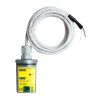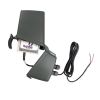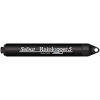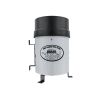RainWise RainLog 2.0 Rainfall Data Loggers
Features
- Utilizes free RL-Loader 2 Software for configuration and data offload
- Powered by two user-replaceable AAA batteries
- Battery monitor LED changes from green to red when battery voltage gets low
- Expedited repair and warranty service
- Lifetime technical support
- More
Overview
The RainWise RainLog 2.0 data logger is RainWise's next-generation Rainfall logger and features numerous improvements in memory capacity, process speed, battery replacement, improved protection and USB Connectivity. This battery-operated logger fits inside most tipping bucket rain gauges. Rainfall is logged at a one-minute resolution and has the capacity for several years of data.
Benefits
- Increased capacity: Flash memory has been increased to 2 MB from 256K
- AAA Batteries: The difficult-to-source lithium CR2477N battery has been replaced with two AAA battery compartments, allowing for easy, un-interrupted replacement in the field
- Battery monitor: The RainLog 2.0 includes a battery monitor LED that changes from green to red when the battery voltage is getting low. The actual battery voltage is also reported in the RL-Loader software
- Rugged Case: Durable case with battery compartment provides better protection
- Improved Protection: Conformal coating to provide better moisture protection
- Processor: Allows for 120% faster downloads
- USB connectivity: A USB mini connector eliminates the need for separate USB converters
In The News
RainWise Weather Stations, Telemetry And Accessories
RainWise is one of the oldest players in the weather monitoring market, having been around since 1974. For reference, that’s only 4 years younger than the U.S. Environmental Protection Agency. Through the years this Maine-based company has logged several advancements in the field starting with RainWise’s very first product, the tipping bucket rain gauge, which is now an industry standard. Since then they have introduced the first consumer digital weather station and the first wireless consumer weather station among other pioneering innovations. With more than 40 years of experience, the products that RainWise produces today are just as inspired.
Read MoreWildfire Prevention in the Sierra Nevada Region with the Yuba Watershed Institute
Though recent wildfires have sparked new conversations about wildfire management and response, groups like the Yuba Watershed Institute have been monitoring the forests and water resources of the Sierra Nevada region for decades, managing approximately 5,000 acres of land with the Bureau of Land Management (BLM) and about 7,000 acres in private land partnerships. The goal of the Institute is to work with local communities and land agencies to improve watershed and forestry management through informed practices and public outreach. The goals of the Yuba Watershed Institute are three-fold: Improve the ability of fire suppression agencies like the California Department of Forestry and Fire Protection ( CAL FIRE ) and the US Forest Service.
Read MoreWave Sensors Integration with NexSens Buoys: A Cutting-Edge Solution for Wave Measurment
Real-time wave data supports accurate weather prediction, safe and efficient maritime operations, and provides valuable safety and operating condition information for recreation and commercial fishing. Understanding wave dynamics also helps with the design of protective coastal structures like seawalls, breakwaters, and jetties. It also supports better prediction of their impact on sediment transport and coastal geomorphology. Wave data is a key factor in qualifying and designing offshore wind farms and harnessing kinetic energy for electrical generation. It helps with the understanding of ocean-atmosphere interactions and contributes to studies of sea-level rise and climate change impacts.
Read More












